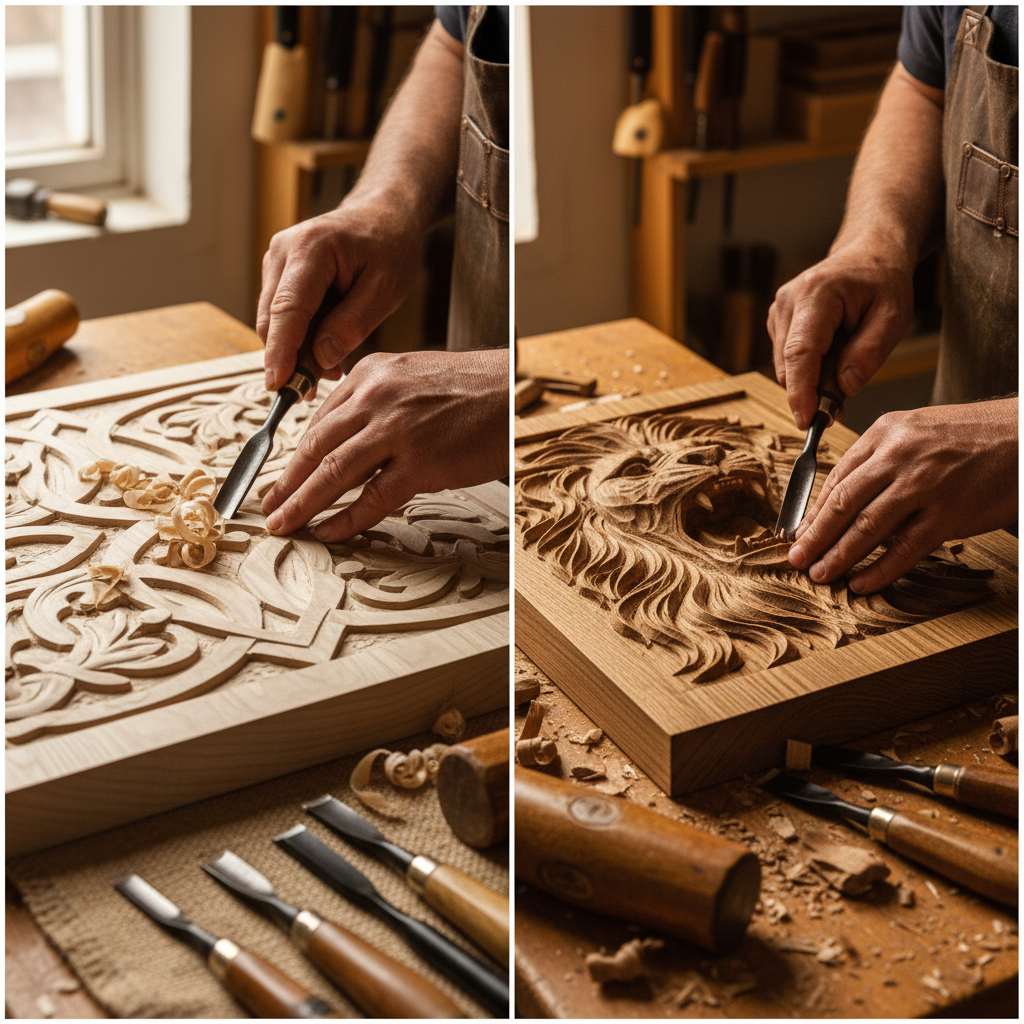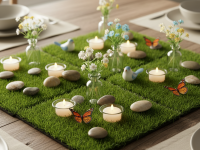Hey there, fellow wood enthusiasts! If you’re anything like me, the joy of turning a simple block of wood into a breathtaking relief carving is an incredibly satisfying experience. There’s something truly magical about watching your vision slowly emerge from the raw material, each stroke of the chisel bringing it closer to life. But before you even make that first cut, there’s a crucial decision to be made: choosing the right wood.
And let’s be honest, for relief carving, two hardwoods often rise to the top of the list for their beauty and durability: Oak and Maple. Both are fantastic in their own right, but they offer vastly different carving experiences and final aesthetics. From my workbench to yours, I’ve spent countless hours with both, wrestling with their grains and celebrating their unique qualities. Today, I want to share my insights and personal experiences to help you navigate this choice for your next relief project. Trust me, picking the right wood can make or break your carving journey!
Understanding Your Canvas: A Quick Intro to Oak and Maple
Before we dive into the nitty-gritty of carving, let’s get acquainted with our two contenders. Both Oak and Maple are celebrated hardwoods, prized for their strength, beauty, and versatility in everything from furniture to flooring. But when it comes to the nuanced world of relief carving, their fundamental differences become incredibly apparent.
-
Oak: The Classic, Rugged Beauty
When you think of Oak, you probably picture its distinctive, pronounced grain. There are primarily two types used in carving: Red Oak and White Oak. White Oak tends to be harder and more rot-resistant, with a slightly warmer tone, while Red Oak is a bit easier to work with but still presents a formidable challenge. Both boast an open-grain structure with prominent medullary rays (those beautiful flecks and streaks) that add incredible character. It’s a wood that screams tradition, strength, and a certain rustic elegance.
-
Maple: The Smooth, Elegant Contender
Maple, particularly Hard Maple (or Sugar Maple), is known for its incredibly fine, closed grain and creamy, often light color. Unlike Oak, its grain is subtle, almost indistinct, allowing the carved form itself to be the star. Soft Maple varieties (like Silver or Red Maple) are less dense but still offer a fine grain structure. Maple is often associated with clean lines, modern aesthetics, and a certain understated sophistication. It’s also famous for unique figures like “birdseye,” “curly,” or “flame” maple, which can add extraordinary visual interest to your carvings, though they can be trickier to work with.
The Grain Game: How It Impacts Your Carving
Ah, the grain! This is arguably the most significant factor that will dictate your carving experience and the final look of your relief project. From my own experience, understanding and respecting the grain is half the battle won.
-
Carving Oak: Dancing with the Grain
Oak’s open, often dramatic grain pattern, especially those prominent medullary rays, demands respect. When carving Oak, you’ll quickly realize that you’re in a constant dance with the wood fibers. Cutting across the grain, or even at certain angles, can lead to tear-out – where chunks of wood splinter away unexpectedly. I’ve learned the hard way that sharp tools are non-negotiable here; dull tools will simply crush the fibers and cause frustration. You need to pay close attention to the direction of the grain and adjust your cuts accordingly, often making a series of delicate stop cuts to define your edges before removing larger sections. While challenging, this distinct grain, when handled correctly, adds an incredible depth and organic texture to your relief carvings. It’s fantastic for projects where you want the wood’s natural character to shine through, perhaps a more traditional or rustic design.
-
Carving Maple: Smooth Sailing for Detail
Maple, with its fine and consistent grain, offers a completely different experience. It’s much more forgiving when carving across the grain, making it an absolute dream for intricate details, sharp lines, and smooth transitions. My chisels seem to glide through maple, producing clean cuts with minimal tear-out, provided they’re sharp, of course! This allows for a level of precision that can be challenging to achieve with Oak. If your relief project involves delicate features, sharp edges, or extremely fine textures – think intricate scrollwork, realistic facial features, or detailed animal fur – Maple will be your best friend. The smooth surface after carving also lends itself beautifully to a polished finish, which we’ll discuss later.
Hardness and Durability: What Your Tools Will Tell You
Both Oak and Maple are hardwoods, but there’s a significant difference in their density that your carving tools (and your hands!) will quickly pick up on.
-
Oak’s Robustness
Oak is undeniably hard and durable. White Oak, in particular, has a Janka hardness rating that puts it among the toughest woods. This density means it stands up well to impact and wear, making it excellent for carvings that might be handled frequently or exposed to the elements (if properly finished). However, this hardness translates directly to more effort at the carving bench. You’ll need to apply more force, and your tools will dull faster. Regular sharpening breaks are not just a good idea; they’re essential for maintaining clean cuts and preventing frustration. Years of carving have taught me that while Oak is tough, it rewards patience and a steady hand.
-
Maple’s Mighty Density
Hard Maple can be even harder than many types of Oak, sometimes boasting an even higher Janka rating. It’s incredibly dense and resistant to dents and scratches. This makes it an excellent choice for durable, long-lasting relief carvings. However, much like Oak, its density means your tools will get a workout. While it carves smoothly, don’t mistake that for ease of cutting. You’ll still need sharp tools and a good amount of physical effort, especially for deeper cuts. Soft Maple, on the other hand, is noticeably easier to carve, offering a good compromise between workability and a fine grain.
Tooling Up: How Each Wood Responds to Your Carving Efforts
The way each wood responds to your chisels, gouges, and knives is a critical part of the carving experience. I’ve spent enough time at the bench to know that a wood’s temperament can either inspire or exasperate you.
-
Working with Oak: Precision and Power
Carving Oak often feels like a battle of wills. It requires precision and, at times, considerable power. Because of its open grain and tendency to splinter, you’ll find yourself needing to make very deliberate, controlled cuts. Undercutting carefully to lift chips rather than trying to plow through can save you a lot of heartache. Small, incremental cuts are your friend. I’ve learned that Oak prefers to be ‘persuaded’ rather than ‘forced.’ It’s also a wood that can take a very crisp, bold edge when carved correctly, especially with sharp tools. This makes it great for relief carvings that have strong, defined lines and shapes.
-
Working with Maple: Grace and Finesse
Maple, in contrast, feels more like a partnership. Its fine grain allows for incredibly smooth, continuous cuts. You can often push a chisel through a longer stroke without fear of tear-out. This lends itself well to techniques that require finesse, like modeling subtle curves, creating delicate textures, or rendering intricate details. While it’s dense and requires sharp tools, the cutting action feels more fluid and predictable. If you enjoy the sensation of your tools gliding through wood, leaving behind a pristine surface, then Maple will bring you immense satisfaction.
Finishing Touches: Bringing Your Relief Carving to Life
Once the carving is done, the finish is what truly brings your masterpiece to life. And here, again, Oak and Maple reveal their distinct personalities.
-
Finishing Oak: Highlighting the Character
Oak’s open grain is a double-edged sword when it comes to finishing. It takes stain beautifully, allowing the pigment to penetrate deeply and highlight that gorgeous, swirling grain pattern. If you want a rustic, traditional look where the wood’s natural character is front and center, staining Oak is a fantastic choice. However, if you’re aiming for a super smooth, glass-like finish, you’ll likely need to use a grain filler to bridge those open pores, which is an extra step. Oil finishes also work wonderfully, bringing out the warmth and depth of the wood without obscuring its texture.
-
Finishing Maple: Polished Perfection
Maple’s closed grain offers a naturally smooth surface that takes finishes exceptionally well. It’s less inclined to blotchiness with stains than some other fine-grained woods, but conditioning can still be beneficial. Where Maple truly shines, though, is with natural finishes like clear lacquer, varnish, or tung oil. These finishes allow its subtle beauty and any delicate carving details to take center stage, often polishing to a remarkable sheen. If you’ve spent hours meticulously carving fine details, Maple’s ability to present those details without a distracting grain pattern is invaluable.
Aesthetic Appeal: What Look Are You Going For?
Ultimately, the final aesthetic of your relief carving is paramount. Consider the environment where your piece will live and the overall message you want it to convey.
-
Oak’s Timeless Grandeur
Oak provides a strong, traditional, and often rustic aesthetic. Its prominent grain adds visual interest and a sense of history. It’s perfect for pieces that evoke classic themes, nature scenes where texture is key, or carvings that will be part of a larger, traditional decor scheme. Think coats of arms, medieval-inspired designs, or bold folk art.
-
Maple’s Modern Elegance
Maple, with its uniform color and subtle grain, offers a more modern, clean, and elegant look. It allows the form and details of your carving to stand out without competing with the wood’s pattern. It’s ideal for contemporary designs, intricate patterns, detailed figurative work, or anything where a smooth, refined finish is desired. It can look crisp and bright, or warm and sophisticated depending on the finish.
Cost and Availability: Practical Considerations
While ofteot the primary decision-maker, cost and availability can play a role. Both Oak and Maple are widely available hardwoods in most regions, and their pricing is often comparable. However, specific types (like highly figured Maple or quarter-sawn White Oak) can command a higher price. Always check with your local lumber suppliers or carving wood specialists for current pricing and stock.
Conclusion: The Best Wood is the One That Speaks to You
So, which is it: Oak or Maple? As with most things in the world of art and craft, there’s no single “right” answer. The best wood for your relief carving project is ultimately the one that aligns with your specific vision, your carving style, and what you want to achieve.
-
Choose Oak if: You love a challenge, appreciate a strong, traditional aesthetic with prominent grain, and your project benefits from a rustic texture or bold, defined shapes. You’re patient and willing to work with the wood’s natural tendencies, and you enjoy the character that an open grain brings to a stained finish.
-
Choose Maple if: You prioritize intricate detail, smooth finishes, and a clean, elegant aesthetic. You want your carving’s form to be the undisputed star, and you enjoy the sensation of your tools gliding through fine-grained wood. You’re aiming for a more modern look or very realistic, detailed representations.
My advice, after all these years? If you’re unsure, try both! Start with a smaller practice piece in each. You’ll quickly discover which wood resonates more with your personal carving style and which one best helps you bring your unique artistic vision to life. The journey of wood carving is one of constant learning and discovery, and exploring different materials is a big part of the fun. Happy carving!



